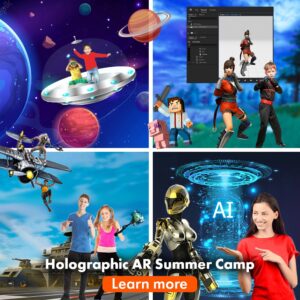Artificial intelligence, or AI, has become increasingly popular in recent years, particularly due to the increased media coverage of things like artificial intelligence robots and AIs that can win at games like chess and go better than even the most skilled human players. However, despite all of this attention, much of the public doesn’t have any idea what artificial intelligence means or how it works. Here’s a quick introduction to AI and how it can be used by kids, teens, and high schoolers today.
What is Artificial Intelligence (AI): Definition and Examples
Artificial intelligence (AI) is the ability of a computer program or a machine to imitate intelligent human behavior. AI is a broad term that encompasses any technique by which a computer simulates some form of intelligent behavior.
Examples include speech recognition, image recognition, robotic process automation, event prediction, and data mining.
There are many misconceptions about artificial intelligence, such as the idea that robots will eventually take over the world or that AI will make humans obsolete.
How does Artificial Intelligence (AI) work?
Artificial Intelligence (AI) is the branch of computer science that aims to make computers behave like humans. Computers can solve problems, recognize patterns, learn from mistakes, and reason in ways that were once only possible for human brains. It’s important to know how AI works because it’s changing our world at an incredible pace!
Imagine a future where machines are taking care of your every need – or worse, where they’ve taken over. To keep this from happening, scientists and engineers are working on artificial intelligence that’s safe to use in all types of industries. The most widely used AI techniques today are machine learning. Let’s take a look at how it all works together!
-
- The first step is collecting data. Machine learning algorithms use large amounts of data to teach a computer to recognize objects, to learn patterns, and to learn what kinds of things might happen next in the process being studied and make strategic decisions.
-
- Then we use data to test the accuracy of the AI to check if AI can get correct results. If the results are not satisfactory, we will need to go back to the Step 1 and find a better way to train the AI. If the result is satisfactory, we then can use the AI in our applications. These AI results can be used to detect what objects are presented, whether there are some special patterns in certain events, and even by companies and organizations to figure out what their best move should be next, whether it’s planning for when demand will go up or figuring out which customers want more information about something specific.
-
- It’s not just about making decisions: predictive analytics also help with understanding trends and predict dangerous so people can make better decisions and prepared to avoid any possible disasters or mitigate any bad events, such as prepare for nature disasters (e.x. earthquake, hurricane, volcano, etc.) before they happen, or monitor, detect and prevent criminal acts such as gun fire, theft, etc.. Now that you know how artificial intelligence works, it’ll be easier to think about its impact on our future!
Why do kids, teens, and high schoolers learn Artificial Intelligence (AI)?
Kids, teens, and high schoolers learn about Artificial Intelligence (AI) because it’s a fascinating field of study that has broad applications in many different industries. AI is all around us, from the way our phones speak to us, to how we find information on the internet. Knowledge of AI is empowering and can lead kids, teens, high schoolers toward a future that involves creative thinking and problem-solving skills. Other interesting topics are deep learning and machine learning. As we have discussed before, machine Learning is about finding patterns through trial and error. Within the machine learning, Deep Learning is a group of high number of layered neural networks. Deep Learning can finding patterns in data sets by using deep neural network structures or other models, The learning process of AI is somewhat like how people learn about new things: from know nothing by exploring data and knowledge in the field, and keep checking the errors and correct them.
Learning AI can help kids, teens, and high schoolers to understand how they can learn things too. Furthermore, teaching kids and teens about artificial intelligence with engaging experiences can open the eyes for them to see the magic of technologies and how they can leverage AI to create. This alone can greatly motive kids and teens to explore their curiosities and innovate with AI. For high schoolers, they can use their AI projects as impressive college application portfolio.
What are the challenges for kids, teens, and high schoolers to learn Artificial Intelligence (AI)?
The challenges for kids, teens, and high schollers to learn Artificial Intelligence (AI) are the same as those for adults. Here is a list of the small portion of challenges:
-
- The AI world is a bit complicated, and AI algorithms are full of complex math equations, most of them involve college or graduate level math understanding, which can make it difficult to understand for young students with high school math, not to say for young kids who are still learning about numbers.
-
- There are so many different types of AI, AI algorithms and AI application fields, and it’s hard to know where to start with all of them. For example, should you start by learning about computer vision or natural language processing? It can be overwhelming at first!
-
- Understanding the terminology used to describe AI concepts.
-
- While artificial intelligence may sound like something out of science fiction movies like The Terminator, it isn’t too far off from what we do on our computers and smartphones every day—it’s just more advanced.
-
- AI is not perfect and AI do things differently from human. So sometimes, while AI can be more powerful and efficient in calculations, AI does need to be properly trained and tested. Otherwise, AI can make silly mistakes. And it can be hard for kids and teens (even experts in the field) to debug the AI system and fix the errors because of the AI’s complexity.
-
- It can be abstract for kids, teens, and high schoolers to learn about all these potential pitfalls when they’re first introduced to AI because they may not have learned about them before. As adults, we should take care in introducing them to this field because students’ brains are still developing, and they may react differently than adults would when they encounter these failures.
-
- Most problematically, fake data or obsoleted old data were used for young students to learn AI. As a result, the AI training results won’t be relevant to the situation. It won’t be real-time. It can’t be used for the current situation. As a results, AI results are not applicable. Kids and teens can’t see the benefits of AI learning and they may draw wrong conclusions about AI. As a result, this kind of learning would diminish their curiosity and create a lot more negative consequences to young students. It is simply better for them not to learn in the first place.
How do kids, teens, and high schoolers learn Artificial Intelligence (AI) at Integem?
Integem has developed a very innovative and interactive way to teach AI.
Holographic AR design which is very visual and interactive. Kids, teens, and high schoolers can use Holographic AR to teleport in the created AI world to see the power of AI.
Students can learn to how AI works, how to train AI, how to improve AI accuracy by directly see the effects in the Holographic AR world. In the next part, students will learn to create their own AI dataset and train their own AI, and then create their own AI applications. And then, students can invite their friends to teleport into their intelligent Holographic AR world to use the power of AI to defeat villains, save lives, or find treasures. If there is an accuracy issue of the AI, they would immediate see the problem and learn how to debug and fix the AI problems. In the entire process, students have in-depth understanding of AI and gained the ability to create with AI, at the same time, students feel a lot of fun and motivation.
Using Holographic AR to teach students AI motivates students to explore their curiosity, push their imaginations into the next level, and empower them to innovate.
Furthermore, students can also learn AI plus Robotics engineering with Holographic AR at Integem and transform the magic of Holographic AR into real-world designs.
Robotics is a very fun field, but also one that’s in high demand. With Integem’s AI+Robotics track you’ll learn how robots work and how to program them. You’ll understand AI algorithms used in robotics and you’ll have gained real-world experience that is sure to put your career on a fast track! Students as young as 6 years old can learn AI design.
Integem is partnering with Nvidia Deep Learning Institute. Students (10 years or older) will learn both AI cloud computing and Edge AI, and can earn Nvidia AI certificates. In our next topic, we will discuss about what is AI cloud computing and AI Edge Computing. Please stay tuned!
Note: Camp Integem offers AI courses for students from kindergarten level to high school AP level. Please learn more at camp.integem.com.




Recent Comments